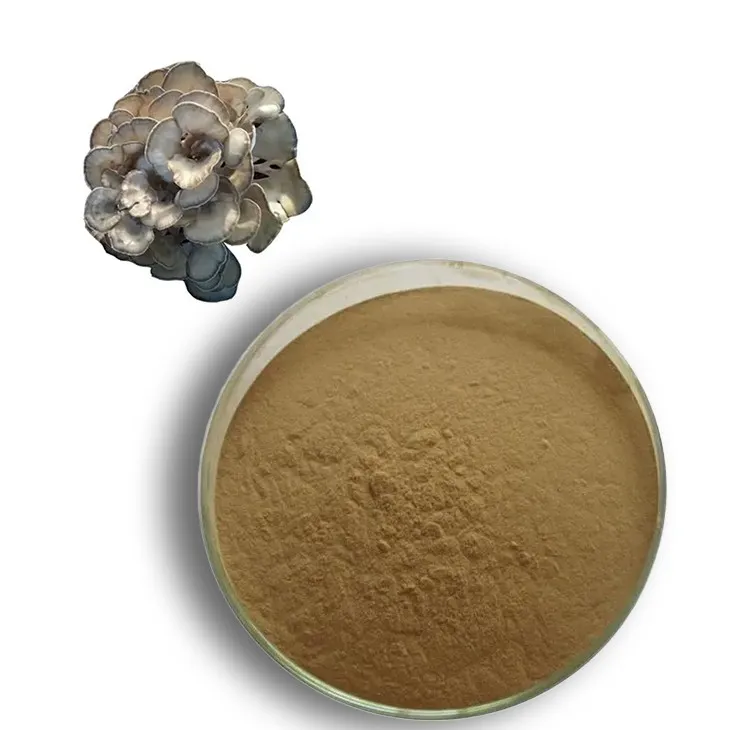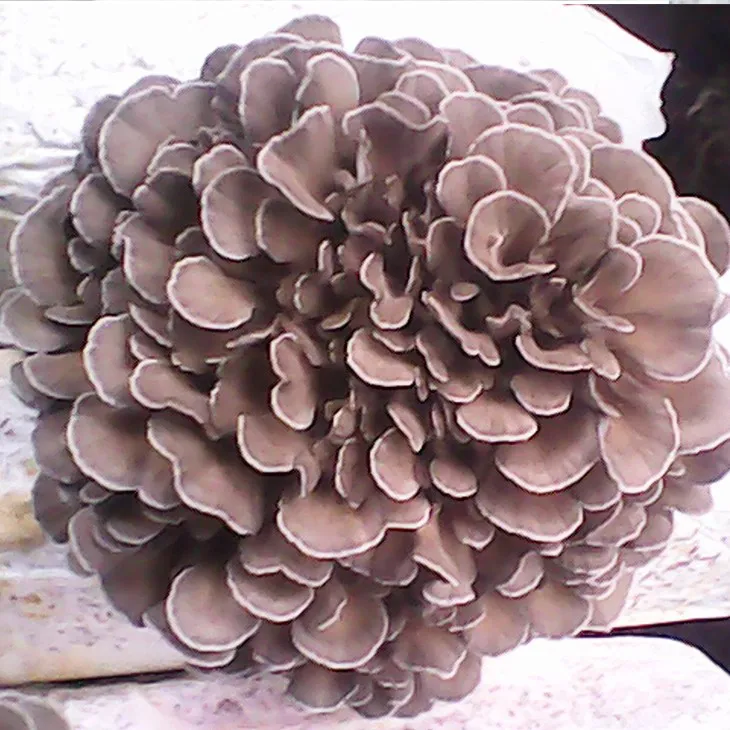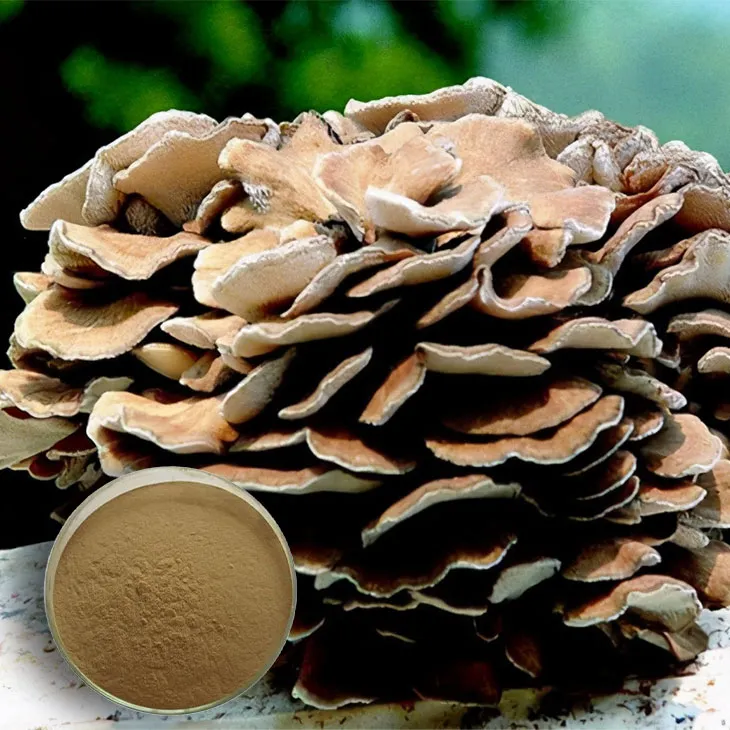- 0086-571-85302990
- sales@greenskybio.com
Maitake Mushroom Extract: China vs. the United States.
2024-11-30

1. Introduction
Maitake mushrooms, scientifically known as Grifola frondosa, have been valued for their potential health benefits for centuries. The extract of maitake mushrooms contains various bioactive compounds such as polysaccharides, beta - glucans, and other nutrients. China and the United States, two major players in the global health and biotechnology fields, approach maitake extract in different but equally interesting ways.

2. China: Rich Biodiversity and Traditional Knowledge
2.1 Natural Habitat and Biodiversity Advantage
China's vast territory and diverse climates provide an ideal natural habitat for maitake mushrooms. The country's rich biodiversity means that maitake mushrooms may have unique genetic characteristics. In some mountainous regions of China, maitake mushrooms grow wild in large quantities, often in association with specific tree species. This natural growth environment may contribute to the formation of distinct chemical profiles in the maitake extract. For example, the soil composition, altitude, and humidity levels in different regions can influence the nutrient uptake and secondary metabolite production of the mushrooms.
2.2 Traditional Chinese Medicine (TCM) Influence
Traditional Chinese medicine has a long - standing history of using maitake mushrooms for medicinal purposes. TCM practitioners believe that maitake can tonify Qi (vital energy), strengthen the spleen, and enhance the immune system. This traditional knowledge has guided the exploration of maitake extract in China. Chinese researchers often start from the TCM perspective when studying maitake extract, aiming to uncover the scientific basis behind its traditional uses. For instance, they may investigate how the polysaccharides in maitake extract interact with the human body's immune system based on the TCM concept of "strengthening the body's resistance."
2.3 Production and Extraction in China
China has a large - scale production of maitake mushrooms, both in wild harvesting (under strict regulation to ensure sustainability) and in artificial cultivation. In terms of extraction methods, Chinese producers often use traditional extraction techniques combined with modern technology. Some common extraction methods include hot - water extraction and ethanol precipitation, which are relatively simple and cost - effective. These methods are designed to preserve the bioactive compounds in the maitake extract while meeting the market demand for large - scale production. However, with the development of the industry, more advanced extraction technologies such as supercritical fluid extraction are also being gradually introduced in China.

3. The United States: Scientific - Innovation Perspective
3.1 Advanced Biotechnology Research
The United States is renowned for its advanced biotechnology research facilities. When it comes to maitake extract, American researchers focus on in - depth understanding of the molecular mechanisms of its bioactive compounds. Using techniques such as genomics, proteomics, and metabolomics, they aim to identify the specific genes, proteins, and metabolites related to the health benefits of maitake extract. For example, they may study how the beta - glucans in maitake extract interact with cell receptors to modulate the immune response at the molecular level. This scientific - based research approach allows for a more precise understanding of the potential of maitake extract.
3.2 Innovation in Product Development
In the United States, there is a strong emphasis on innovation in the development of maitake extract - based products. Companies are constantly exploring new formulations, such as combining maitake extract with other bioactive substances like vitamins or probiotics to create more comprehensive health supplements. Moreover, the use of nanotechnology in the formulation of maitake extract products is also being investigated. Nanotechnology can potentially improve the bioavailability of the extract, allowing for better absorption in the human body. This kind of innovation - driven product development is aimed at meeting the diverse and high - end demands of American consumers.
3.3 Production and Quality Control in the US
The production of maitake extract in the United States is highly regulated. Stringent quality control measures are in place to ensure the purity, potency, and safety of the extract. From the cultivation of maitake mushrooms in controlled environments to the extraction process and final product packaging, every step is closely monitored. For example, Good Manufacturing Practice (GMP) regulations are strictly adhered to in the production facilities. Additionally, the US Food and Drug Administration (FDA) has specific guidelines for dietary supplements containing maitake extract, which further safeguard the quality of the products on the market.

4. Regulatory Frameworks
4.1 China's Regulatory Situation
In China, the regulatory framework for maitake extract is part of the broader regulations for traditional Chinese medicine and health products. The State Administration for Market Regulation oversees the production, marketing, and quality control of maitake extract - related products. For products claiming medicinal properties, more stringent approval procedures are required, which often involve pre - clinical and clinical trials. However, for general health products containing maitake extract, the regulatory requirements are relatively more flexible, mainly focusing on safety and basic quality standards. This regulatory approach encourages the development of the maitake extract industry while ensuring consumer safety.
4.2 US Regulatory Framework
The US regulatory system for maitake extract - based products is complex. As mentioned before, the FDA has guidelines for dietary supplements. These products are not subject to the same pre - approval process as drugs, but they must meet certain safety, labeling, and manufacturing standards. Manufacturers are responsible for ensuring the safety and proper labeling of their products. However, if a product makes specific health claims that are more in the realm of drugs, it may be subject to more intensive regulatory scrutiny. This regulatory framework strikes a balance between promoting innovation in the dietary supplement industry and protecting consumer health.
5. Consumer Acceptance
5.1 Consumer Attitudes in China
In China, consumers have a relatively high acceptance of maitake extract products, mainly due to the influence of traditional Chinese medicine. Many Chinese consumers believe in the natural and holistic health benefits of maitake mushrooms based on their traditional knowledge. Maitake extract products are often seen as a way to supplement nutrition, enhance immunity, and improve overall health. Moreover, with the increasing awareness of health and wellness in China, the market demand for maitake extract - based products, especially those with reliable quality, is on the rise.
5.2 Consumer Attitudes in the US
In the United States, consumer acceptance of maitake extract products is also growing. American consumers are generally more interested in products that are backed by scientific research and evidence - based health claims. Therefore, the scientific - innovation - driven development of maitake extract products in the US is more likely to attract consumers. Additionally, as the trend towards natural and alternative medicine gains popularity in the US, maitake extract, as a natural product with potential health benefits, is gradually becoming more recognized and accepted by American consumers.
6. Potential Future Developments
6.1 China's Future Outlook
China is likely to further integrate traditional knowledge with modern scientific research in the field of maitake extract. With the continuous improvement of extraction and purification technologies, Chinese producers may be able to produce higher - quality maitake extract with more concentrated bioactive compounds. In addition, China may also expand its international market share of maitake extract products by strengthening quality control and standardization. Moreover, more research on the combination of maitake extract and other traditional Chinese medicine ingredients is expected, which may lead to the development of new multi - component health products.
6.2 US Future Outlook
The United States will probably continue to lead in scientific research and innovation related to maitake extract. Future developments may include more in - depth exploration of the potential medical applications of maitake extract, such as its use in cancer treatment or chronic disease prevention. The US may also see the emergence of more personalized maitake extract - based products, tailored to individual genetic profiles and health needs. Additionally, as the global demand for natural health products increases, the US may strengthen its cooperation with international partners in the production and marketing of maitake extract products.
7. Conclusion
In conclusion, both China and the United States have their own characteristics in the field of maitake extract. China's rich biodiversity and traditional knowledge provide a solid foundation for the exploration of maitake extract, while the United States' scientific - innovation approach drives in - depth research and product innovation. The different regulatory frameworks in the two countries also reflect their respective policy priorities. With the increasing global interest in maitake extract for its potential health benefits, both China and the United States are expected to play important roles in the future development of this field, whether through traditional - modern integration in China or scientific - innovation - led development in the United States.
FAQ:
1. What are the main differences in the production process of Maitake extract between China and the United States?
In China, the production of Maitake extract may be more influenced by traditional extraction methods based on its long - standing traditional knowledge. This could involve techniques passed down through generations. In the United States, with advanced biotechnology, the production process is likely to be more high - tech, such as using more precise enzymatic extraction or supercritical fluid extraction methods. The US may also have stricter quality control measures in line with its scientific - innovation approach.
2. How do regulatory frameworks for Maitake extract differ in China and the United States?
In China, the regulatory framework for Maitake extract may be part of a broader set of regulations governing traditional Chinese medicine and food supplements. It may focus on aspects such as safety, authenticity, and compliance with traditional use. In the United States, the regulatory approach may be more centered around treating Maitake extract as a dietary supplement. The US Food and Drug Administration (FDA) has specific regulations regarding the safety, labeling, and marketing of dietary supplements, which are designed to ensure consumer protection while also allowing for innovation in the supplement industry.
3. What are the levels of consumer acceptance of Maitake extract in China and the United States?
In China, due to its rich traditional knowledge, consumers may be more receptive to Maitake extract as part of traditional medicine or health - promoting products. It may be commonly used in traditional health practices. In the United States, consumer acceptance may be more related to its perceived health benefits as a dietary supplement. Health - conscious consumers in the US may be attracted to Maitake extract for its potential immune - boosting, anti - cancer, or other health - related properties, but overall acceptance may be influenced by marketing, scientific research, and consumer education.
4. How does the unique biodiversity in China contribute to the characteristics of Maitake extract?
China's rich biodiversity provides a diverse range of environmental conditions for Maitake mushrooms to grow. Different soil types, climates, and altitudes can lead to variations in the chemical composition of Maitake mushrooms. These variations may translate into unique characteristics in the extract, such as different levels of bioactive compounds. For example, certain regions in China may produce Maitake mushrooms with higher levels of polysaccharides, which are known for their potential health benefits, compared to mushrooms grown in other areas.
5. What are the potential future developments of Maitake extract in China and the United States?
In China, future developments may involve further exploration of traditional uses and integration with modern medicine. There could be more research on optimizing extraction methods based on traditional knowledge. In the United States, with its focus on scientific innovation, future developments may include more in - depth research on the molecular mechanisms of Maitake extract's health benefits. There may also be an expansion of its use in functional foods and nutraceuticals, as well as more collaborations between research institutions and the industry to develop new products.
Related literature
- Maitake Mushroom: A Promising Source of Bioactive Compounds"
- "Comparative Analysis of Maitake Extracts from Different Geographical Origins"
- "Regulatory Aspects of Dietary Supplements in the United States and China: A Focus on Maitake Extract"
- "Consumer Perception and Acceptance of Mushroom - Based Supplements: The Case of Maitake in China and the US"
- ▶ Hesperidin
- ▶ citrus bioflavonoids
- ▶ plant extract
- ▶ lycopene
- ▶ Diosmin
- ▶ Grape seed extract
- ▶ Sea buckthorn Juice Powder
- ▶ Beetroot powder
- ▶ Hops Extract
- ▶ Artichoke Extract
- ▶ Reishi mushroom extract
- ▶ Astaxanthin
- ▶ Green Tea Extract
- ▶ Curcumin Extract
- ▶ Horse Chestnut Extract
- ▶ Other Problems
- ▶ Boswellia Serrata Extract
- ▶ Resveratrol Extract
- ▶ Marigold Extract
- ▶ Grape Leaf Extract
- ▶ blog3
- ▶ blog4
-
Organic non - transgenic nutmeg extract.
2024-11-30
-
The pure vitamin B9 most worth buying.
2024-11-30
-
High - quality oyster peptide products.
2024-11-30
-
The best natural source of selenium yeast.
2024-11-30
-
Diosmin with the best reviews.
2024-11-30
-
Certified organic echinacea extract.
2024-11-30
-
Lemon Balm Extract
2024-11-30
-
Scutellaria Extract
2024-11-30
-
Wheat Germ Extract
2024-11-30
-
Withania Somnifera Extract
2024-11-30
-
Jujube Extract
2024-11-30
-
Hawthorn Extract
2024-11-30
-
Citrus Aurantii Extract
2024-11-30
-
Bamboo Leaf extract
2024-11-30
-
Lycopene
2024-11-30
-
Clove Powder
2024-11-30





















